This publish could include affiliate hyperlinks. We could earn cash or merchandise from the businesses talked about on this publish.
Did you lately undertake a lovable mutt and are actually questioning the right way to socialize a rescue canine?
In spite of everything, socialization for rescue canine is extremely vital because it helps them alter to their new houses, and builds confidence.
Sadly, many rescue canine have skilled trauma, neglect, or restricted socialization of their previous, which might result in concern, nervousness, and behavioral points.
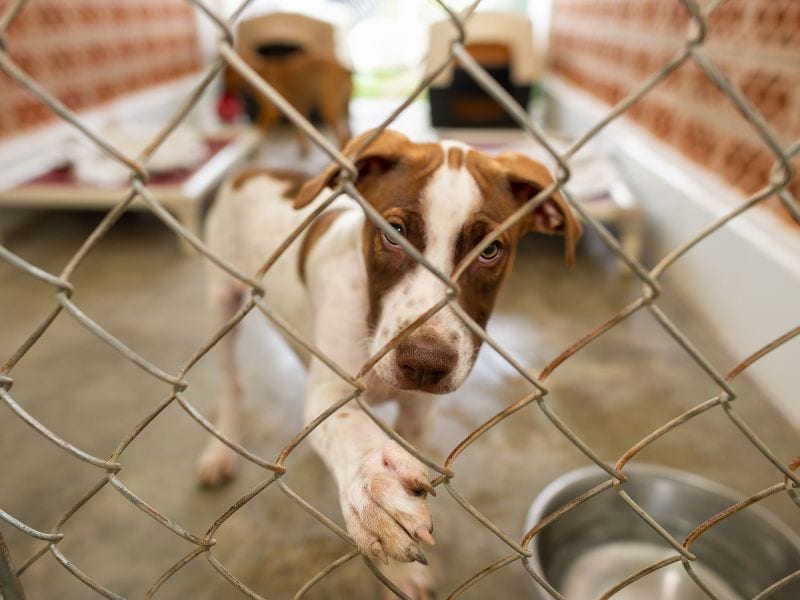
I skilled this primary hand with my pup Wally, a 38 lb Feist combine, whom I adopted in 2019 from a rescue group in Central NC.
He had no hassle with individuals however wasn’t loopy about passing different canine on leash.
Again in my skilled canine strolling days, a number of of my purchasers additionally adopted rescue canine or have been fostering them, so I’ve seen just a few behavioral quirks over time.
Sadly, that features one rescue story gone improper which resulted in having to place the pup down.
So on this weblog publish, I’m going to share ideas and methods for the right way to socialize a rescue canine.
I’ll additionally clarify what went improper within the socialization strategy of the rescue canine that didn’t make it.
Prepared? Let’s soar proper in!
How To Socialize A Rescue Canine
Key factors for this final information:
- Understanding Your Rescue Canine – My Rescue Canine Wally As An Instance
- Key Components To Assist Socialize A Rescue Canine
- Crate Coaching And Designated Areas For Socializing Rescue Canines
- Establishing A Routine And Offering Constant Boundaries For Your Rescue Canine
- Progressively Exposing Your Rescue Canine to New Environments
- Constructive Reinforcement Coaching To Assist Socialize A Rescue Canine
- Fundamental Obedience Coaching & Key Instructions For Rescue Canines
- Why Constructive Social Interactions Are Essential For Your Rescue Canine
- Examples Of Actions To Assist Socialize Your Rescue Canine
- A Rescue Story Gone Fallacious
Understanding Your Rescue Canine – My Rescue Canine Wally As An Instance
Rescue canine typically face distinctive challenges on account of their backgrounds, which might fluctuate extensively relying on their particular person experiences.
Wally, for instance, had been pulled from a kill-shelter in rural NC by a rescue group referred to as It takes A Village Rescue. They pulled him when he was slightly over one 12 months previous.
Earlier than he was surrendered on the shelter, he had already been to 2 completely different houses, and that’s inside the first 12 months of his life!
I think that 4 distinct elements contributed to his give up:
(1) His power ranges. As a squirrel looking canine, this boy wants lengthy walks each single day, and I discovered that backpack walks are splendid to assist burn all of his power.
He’s undoubtedly not the form of canine that may simply hand around in the yard.
He NEEDS a number of each day walks.
(2) His meals allergic reactions. When he got here into my life, Wally was one itchy pup who stored scratching, and scratching, and scratching.
After some trial and error that included taking a pet allergy test, I came upon that he can’t have any rooster, quail, salmon, anchovies, potatoes and likewise no grains together with a number of veggies.
And go determine, the kibble he got here to me with had rooster and potatoes on the ingredient checklist, so it was no marvel he was so depressing.
Since he’s allergic to many widespread pet food components, that decreased his meals selections significantly.
That’s why I went forward and switched him from kibble to uncooked pet food and he’s been doing nice ever since.
(3) His love for shredding issues. Principally plush toys, however sadly not simply plush canine toys, but additionally plush children toys.
He additionally likes “kidnapping” them from cabinets in pet retail shops!
I began engaged on this with him and he’ll now let go of them in alternate for a tasty deal with, however finally, he nonetheless needs to tear them aside.
(4) His lunging at different canine we cross on leashed walks. He does superb with canine off leash and has a number of doggie associates he performs with within the yard.
I’ve additionally been engaged on this with him and we’ve made progress so far as the gap that units him off, nevertheless it’s nonetheless a piece in progress.
Conserving all these challenges in thoughts, I’ve taken a number of approaches to fixing them. As I simply laid out, some have been simpler and faster to repair than others.
All in all, it took me about 3 months to seek out out about all of his quirks, which is identical time he wanted to really really feel at residence with me.
When you consider it from his perspective, that’s fully comprehensible.
He will need to have been questioning whether or not I’d be taking him some other place but once more since that’s all he had skilled as much as that time in life.
Now, 4 years later and whereas I’m typing this, Wally’s lounging in his canine kennel, snoozing away fortunately after our one hour noon stroll.
That’s the second hour stroll he will get every single day, the primary one being his pre-breakfast morning stroll.

Rescue pup Wally stress-free in his crate
What To Count on From Your Rescue Canine
Clearly, each rescue canine has a novel historical past and can have completely different quirks and triggers.
Some could also be just like Wally’s, and a few could also be completely different.
That mentioned, I listed a number of examples of what chances are you’ll anticipate out of your rescue canine:
1. Concern and Nervousness
Many rescue canine have skilled trauma, abuse, or neglect of their previous.
In consequence, they might exhibit concern and nervousness in new conditions, round unfamiliar individuals, or after they’re uncovered to sure stimuli.
The next are widespread physique postures in fearful canine:
- Cowering
- Trembling
- Tucked tail
- Tense physique
- Ears pinned again
- Lip licking and extreme yawning
- Extensive eyes with the white of their eyes displaying
2. Lack of Socialization
Rescue canine could not have had correct socialization through the first 4 months of their lives, which is a formative, essential section for puppies.
This may end up in difficulties in interacting with different canine, animals, or people.
They could be fearful, exhibit reactive habits, or battle with applicable social cues.
I think that Wally wasn’t correctly socialized to different canine when he was a pet, which might clarify his response to different (principally leashed) canine we encounter on our walks.
3. Belief Points
Constructing belief with a rescue canine is usually a vital problem.
They could have skilled damaged belief previously, making it tough for them to kind new attachments and bonds.
Know that it takes time, persistence, and constant constructive experiences to earn their belief.
However your rescue pup may additionally shock you – given what number of occasions Wally was handed round throughout only one 12 months, I used to be very stunned at how briskly he trusted me!
4. Behavioral Points
Rescue canine could show a spread of behavioral points, together with:
- Separation nervousness
- Useful resource guarding
- Leash reactivity
- Aggression
These behaviors could have developed as coping mechanisms of their earlier circumstances.
5. Adjustment to New Environments
Transferring from a shelter or foster residence to a everlasting residence is usually a vital transition for rescue canine.
They want time to acclimate to new environment, routines, and family guidelines.
On common, you’ll be able to anticipate the transition interval to final about 3 months.
Key Components To Assist Socialize A Rescue Canine
That’s why persistence and constructive reinforcement are important parts whenever you’re serving to a rescue canine settle into their new residence and belief you.
Right here’s why they’re so vital:
1. Endurance
You might already know that persistence is vital in canine coaching as some canine be taught slower than others.
On that notice, I bear in mind educating my late pup Missy the rollover trick. It took her FOREVER and I used to be on the verge of giving up when she lastly rolled over after practising for six+ months!
That mentioned, persistence can be essential whenever you’re engaged on socializing your rescue pup.
I noticed this repeatedly at one in all my canine strolling/pet sitting purchasers’ who fostered Beagles frequently.
The foster pups got here straight from a loud, small shelter setting and it normally took them just a few weeks to begin to calm down of their new setting.
The shopper’s 3 resident pups at all times helped them with the transition because the foster pups might observe them and duplicate their habits.
For instance, rolling round on the grass (or no matter else!) within the yard, asking the people for stomach rubs, having enjoyable chasing a ball, or anticipating yummy treats in the direction of the top of a pet sitting go to.
So if you have already got canine, they’ll be serving to you along with your rescue pup!
No worries for those who don’t, simply do not forget that it might take slightly longer with out the assistance of assured canine who’re already used to the nice doggie life.
2. Constructive Reinforcement
Constructive reinforcement is a robust instrument in socializing a rescue canine.
By rewarding desired behaviors with tasty treats, verbal reward, or play, you create a constructive affiliation and encourage the canine to repeat these behaviors.
Wally for instance will do ANYTHING for a tasty deal with!
In order that’s what I’ve been utilizing to reward good habits, particularly once we’re out on walks and are passing different canine.
In case your rescue pup isn’t meals motivated, attempt rewarding him with canine toys.
For instance, squeaky chuck-it balls. They arrive in several sizes, and small chuck it balls match simply superb into canine deal with pouches!
Or possibly they’re motivated by the upbeat, completely happy sound of your voice!
Whatever the particular sort of constructive reinforcement you employ along with your pup, it helps:
- Construct their confidence
- Establishes belief, and
- Strengthens the bond between you and the pup.
It additionally encourages them to view social interactions and new experiences as constructive and rewarding.
3. Constructing Belief
Endurance and constructive reinforcement each contribute to constructing belief along with your rescue canine!
Belief is the muse for profitable socialization.
By persistently offering constructive experiences, respecting their boundaries, and avoiding punishment-based strategies, you foster a way of security and safety.
As belief grows, your rescue pup turns into extra open to exploring new environments, interacting with others, and overcoming their fears.
Crate Coaching And Designated Areas To Assist Socialize A Rescue Canine
A safe and peaceable setting performs a significant position in offering consolation and stability for a rescue canine throughout their socialization course of.
That’s why crate coaching and designated areas are vital for rescue canine as they supply:
1. A Secure and Safe Area
A canine crate or designated space like a canine play pen serves as a secure and safe house for a rescue canine.
It offers them with a devoted spot the place they’ll retreat and really feel protected after they want some alone time, or after they’re feeling anxious or overwhelmed.
When Wally got here to stay with me, I arrange my late pup Missy’s crate for him, and all of my purchasers’ rescue Beagles had their very own crates too.
2. Boundaries and Construction
Rescue canine, particularly these with unsure backgrounds, can profit from clear boundaries and construction.
Crate coaching and designated areas set up boundaries inside the residence and assist the canine perceive their private house.
This construction offers them with a way of stability and helps them alter extra simply to their new setting.
3. Help in Housetraining
Crate coaching may also be significantly helpful for home coaching a rescue canine.
That’s as a result of canine have an instinctual need to maintain their den or sleeping space clear.
By utilizing a crate as their designated den, they’re much less prone to remove inside it, which might speed up the housetraining course of.
A correctly sized crate may forestall accidents in different areas of the house when the pup is unsupervised.
Our favourite crates are the wire crates by MidWest Properties!
Whereas wire crates should not as fairly as wood crates, they make escaping them a lot more durable!
I noticed firsthand what a bored rescue pup (the one which ended up having to be put down) can do to a wood crate…chew the heck out of it and escape.
4. Administration of Conduct
When correctly launched and used, a crate can forestall damaging behaviors like chewing furnishings or entering into hassle.
Nevertheless, it’s vital to notice {that a} crate shouldn’t be used for lengthy hours of unreasonable confinement!
And positively not with out correctly exercising the pup as drained canine are a lot much less prone to act up.
Having mentioned that, grownup canine ought to get to stretch their legs and go for potty breaks roughly each 4 hours, whereas puppies want extra frequent crate breaks.
5. Facilitating Journey and Transition
Crate coaching can be beneficial whenever you’re touring or throughout transitional durations.
For instance, whenever you’re shifting to a brand new residence.
After I moved from the US to Germany with Wally in 2021, the truth that he was crate skilled was a lifesaver as he needed to journey within the stomach of the airplane!
About 3 months earlier than the massive transfer, I switched out his MidWest wire crate for an airline-approved journey crate.
That means, he had loads of time to get used to it and I’m completely happy to report that he did rather well on journey day!
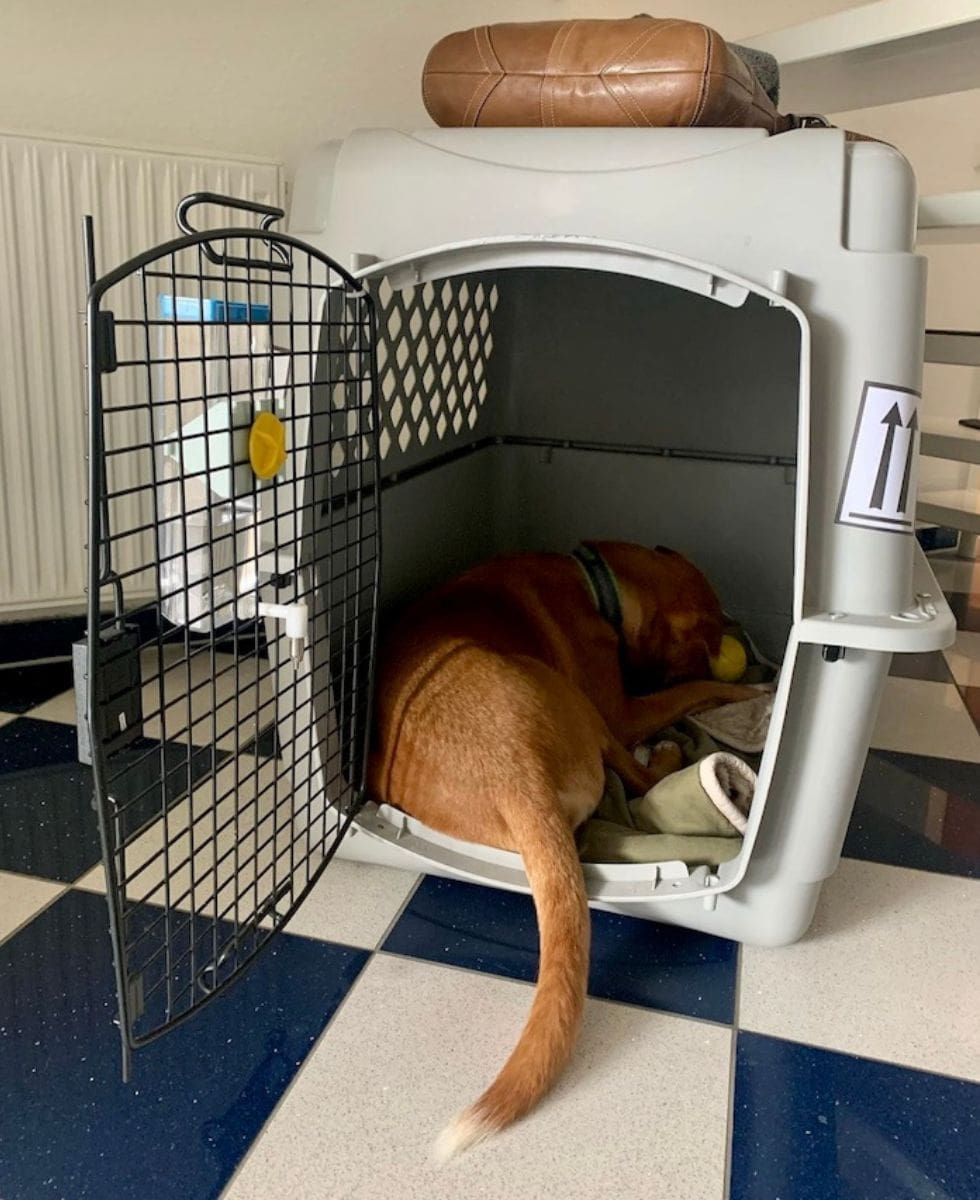
Wally in his journey crate on day 1 at our new place in Germany
6. Consolation and Familiarity
Crate coaching and designated areas give rescue canine a way of consolation and familiarity.
By offering them with their very own house that’s stuffed with their very own bedding, toys, and acquainted scents, it turns into a spot the place they’ll calm down and really feel comfortable.
However bear in mind, crate coaching ought to at all times be completed utilizing constructive reinforcement methods.
As you introduce your rescue pup to their new crate, go away the door open and allow them to discover it at their very own tempo.
To make it extra attention-grabbing for them to discover it, you’ll be able to place their meals bowls in there, tasty treats or a favourite toy!
Fortunately, canine are curious by nature and can ultimately need to have a look.
That mentioned, please by no means use the crate as a type of punishment or confinement for prolonged durations.
In spite of everything, we would like our rescue pups to think about the crate a secure house they sit up for hanging out in, and never one they hate.
Establishing A Routine And Offering Constant Boundaries For Your Rescue Canine
Establishing a routine and offering constant boundaries are essential for the profitable socialization of rescue canine.
Right here’s why they’re vital:
1. Stability and Predictability
Establishing a routine offers rescue canine with a way of stability and predictability of their each day lives.
Having constant feeding occasions, train schedules, and common actions helps them really feel safer and reduces nervousness.
Because it permits them to anticipate what comes subsequent, it promotes a way of security and luxury.
Right here’s what Wally’s each day schedule normally seems to be like:
- 1 hour morning stroll
- Breakfast
- Morning nap
- 1 hour noon stroll
- Afternoon nap
- 20-30 minute potty break
- Dinner
- Lounging on the sofa together with his people
- Playtime
- Final potty break of the day
- Settling in for the evening in his crate
After we journey with him by automotive, which we do 2-3 occasions per 12 months, this schedule adjustments a bit, however his breakfast and dinner occasions stay the identical.
2. Clear Boundaries and Expectations
Constant boundaries set clear expectations for the canine’s habits and permit the canine to be taught applicable responses and self-control – very like children want boundaries!
Rescue canine could have by no means realized correct guidelines or boundaries, so offering them with constant tips helps them perceive what is suitable and what’s not.
For instance, they might must be taught that counter browsing (Wally!), chewing on furnishings and scratching up your doorways are large no no’s!
On that notice, take a look at our weblog publish Tips on how to cease a canine from chewing on issues to find out about methods that work.
3. Constructing Belief and Confidence
As I’ve identified beforehand, rescue canine typically want time to develop belief and confidence of their new setting and with their new caregivers.
Consistency in routine and bounds helps construct this belief!
When the pup realizes that:
- Their strolling, enjoying and consuming wants are persistently met
- Boundaries are persistently enforced, and
- The setting stays predictable, they start to really feel safer and assured of their environment.
4. Facilitating Coaching and Studying
A constant routine and clear boundaries additionally assist with any canine coaching and general studying course of.
Canines thrive on consistency and repetition as a result of it makes it simpler for them to grasp and retain coaching cues and instructions.
So when the canine is aware of what to anticipate and receives constant constructive reinforcement for desired behaviors, they’ll progress extra successfully of their coaching and socialization.
5. Emotional Properly-Being
Having a routine and constant boundaries additionally positively impacts a rescue canine’s emotional well-being.
That’s as a result of they scale back stress, uncertainty, and confusion.
So by offering construction and predictability, you create an setting that helps their psychological and emotional stability.
This contributes to a happier, extra balanced, and assured rescue canine.
Progressively Exposing Your Rescue Canine To New Environments
Gradual publicity to new environments and stimuli is a key technique whenever you socialize your rescue canine.
This method entails introducing the canine to unfamiliar:
- Conditions
- Folks
- Animals
- Objects
in a managed and incremental method.
The purpose is to assist the canine develop constructive associations and construct confidence, which finally reduces concern and nervousness.
Right here’s how gradual publicity works:
1. Begin with Acquainted Environments
Start socialization in a cushty and acquainted setting, similar to your property or a quiet out of doors house.
Permit the canine to discover and change into accustomed to their speedy environment earlier than shifting on to more difficult environments.
2. Introduce One Stimulus at a Time
Introduce new stimuli step by step, specializing in separately.
This might embody new sounds, sights, smells, or experiences.
For instance, begin with mild sounds, step by step growing the extent of publicity because the canine turns into extra snug.
3. Use Desensitization Strategies
Desensitization entails exposing the canine to a stimulus at a low depth and step by step growing it over time.
For example, if the canine is petrified of loud noises, begin by enjoying a recording of a low-volume noise and step by step elevate the amount because the canine exhibits indicators of rest and luxury.
This could work nice as a means of desensitizing your rescue canine to the sound of fireworks or thunder!
You’ll discover plenty of YouTube movies that play thunder and fireworks sounds to desensitize canine.
Since Wally is VERY meals motivated, I additionally at all times give him a pet food puzzle together with the sounds, whether or not recorded or occurring stay.
That means, he associates the loud sounds with good issues occurring.
Our favourite pet food puzzles are:
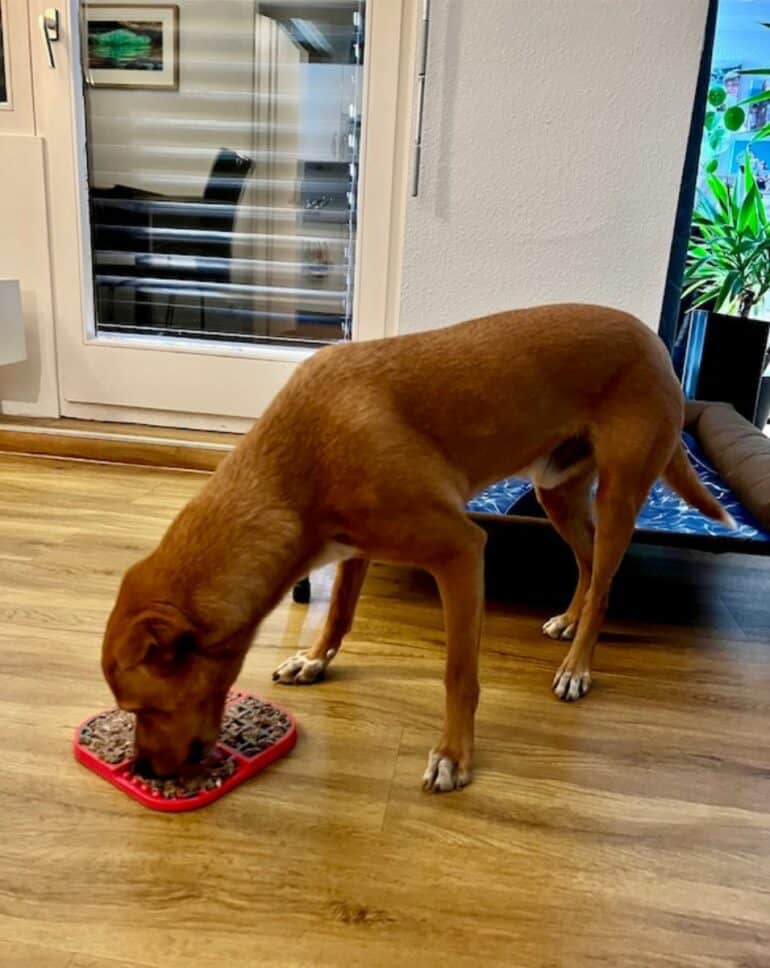
Wally’s frozen LickiMat Slomo options floor uncooked pet food
4. Constructive Reinforcement
Throughout every publicity, use constructive reinforcement methods to reward the canine for calm and assured habits.
Provide yummy treats, verbal reward, or play as a reward for being courageous pups!
This helps create constructive associations with the brand new environments or stimuli and reinforces the fascinating habits of staying calm.
5. Monitor Physique Language
Once you introduce your pup to new stimuli, pay shut consideration to their physique language all through the method.
Indicators of stress or nervousness point out that you could be have to decelerate or alter the depth of the publicity.
For instance:
- Trembling
- Panting
- Salivating
- Avoidance
Keep in mind, each canine is exclusive, so respect their consolation zone and progress at their particular person tempo.
6. Progressively Enhance Problem
Because the canine turns into extra snug with every publicity, step by step enhance the extent of problem.
Introduce new environments, novel experiences, and interactions with unfamiliar individuals or animals.
With Wally, I took him to dog-friendly retailers like pet retail shops after they weren’t tremendous busy.
He acquired to say hello to the workers, normally acquired a free deal with, and we practiced just a few obedience instructions as we have been strolling down the completely different aisles.
For my purchasers’ rescue Beagles, they acquired to see me on a Monday-Friday foundation after I got here for his or her each day noon visits.
Except they have been being handled for heartworms or different medical points, additionally they went to canine adoption occasions after just a few weeks, the place they clearly met extra individuals and different canine.
7. Non-compulsory: Search Skilled Steerage
For those who encounter vital challenges or in case your rescue pup shows extreme concern or aggression, it’s best to search steerage from knowledgeable canine coach or behaviorist skilled in working with rescue canine.
They will present professional recommendation and help tailor-made to the precise wants of your canine.
Keep in mind, the important thing to profitable gradual publicity is persistence and understanding.
Every canine progresses at their very own tempo, and it’s important to respect their particular person wants and luxury ranges.
Constructive Reinforcement Coaching To Assist Socialize A Rescue Canine
Constructive reinforcement coaching strategies are extremely efficient for socializing rescue canine.
These strategies give attention to rewarding fascinating behaviors somewhat than punishing undesirable ones.
Right here’s why constructive reinforcement coaching is useful to socialize a rescue canine:
1. It Builds Belief and Confidence
Constructive reinforcement coaching establishes a bond of belief between the canine and their proprietor as they be taught to depend on their new human as a supply of rewards.
By utilizing meals, toys and verbal rewards, the canine learns to affiliate social interactions and new experiences with constructive outcomes, which helps construct their confidence.
2. It Encourages Desired Conduct
Constructive reinforcement coaching focuses on rewarding and reinforcing desired behaviors.
When a rescue canine shows applicable social behaviors similar to calmness, friendliness, or correct manners, they obtain the rewards.
This encourages them to repeat these behaviors.
3. It Reduces Concern and Nervousness
As we’ve already established, rescue canine could have concern or nervousness on account of previous experiences.
Constructive reinforcement coaching offers a constructive and supportive setting that helps alleviate their fears.
By specializing in rewards and constructive associations, the canine learns to affiliate socialization with nice experiences, which reduces nervousness and concern responses.
4. It Allows Efficient Communication
Constructive reinforcement coaching permits for clear and efficient communication between the proprietor and the rescue canine.
By rewarding desired behaviors, the canine understands what is predicted of them.
5. It Promotes Emotional Properly-Being
Constructive reinforcement coaching promotes the emotional well-being of rescue canine.
That’s as a result of it creates a constructive and nurturing setting the place the canine feels secure, beloved, and valued.
Fundamental Obedience Coaching & Key Instructions For Rescue Canines
With regards to primary obedience coaching and educating key instructions to a rescue canine, listed below are some ideas that will help you:
1. Begin With The Fundamentals
Start by specializing in important instructions similar to “sit,” “keep,” “down,” and “come.”
These instructions lay the muse for good habits and security.
You’ll be able to learn extra about the right way to train them (and others!) in our weblog publish 21 Canine Coaching Instructions.
2. Keep in mind To Use Constructive Reinforcement
I’ve already pointed this out just a few occasions, however I’ll say it once more:
Constructive reinforcement is essential.
Reward your canine with yummy treats, verbal reward, or play and toys each time they exhibit the specified habits or reply appropriately to a command.
This encourages them to repeat the habits and strengthens the educational course of.
3. Preserve Coaching Classes Brief and Constructive
Preserve coaching periods quick, round 10-Quarter-hour, to keep up the canine’s consideration and forestall them from turning into overwhelmed.
Make coaching a constructive expertise by incorporating play and treats, and at all times finish on a constructive notice.
For those who’re nonetheless old fashioned and watch common TV, you should utilize the industrial breaks for brief coaching periods!
4. Be Constant
Consistency is essential in (rescue) canine coaching.
Use the identical instructions and hand indicators persistently, and guarantee everybody within the family follows the identical coaching strategies and cues.
That features your partner, children, canine walkers and pet sitters.
This helps keep away from confusion and reinforces the canine’s understanding of the instructions.
5. Apply in Totally different Environments
Progressively introduce coaching periods in numerous environments to assist your rescue canine generalize instructions.
Begin in a quiet and acquainted house, then step by step add distractions and follow outdoor or in public areas.
This helps the canine be taught to reply to instructions in several contexts.
Clearly, tough instructions just like the “come” command are going to be more difficult within the distracting outdoor than inside your property, however one great way of practising them exterior is on a lengthy leash!
6. Break Instructions into Steps
For complicated instructions just like the “Depend command”, break them down into smaller, manageable steps.
Educate every step individually and step by step mix them – we additionally share the right way to train this explicit command in our weblog publish 21 Canine Coaching Instructions!
This incremental method helps your pup perceive and achieve studying the complete command.
7. Keep Constructive
Above all else, method coaching with a constructive mindset!
Canines choose up on our power, so keep a relaxed and constructive demeanor throughout coaching periods.
This creates a conducive setting for studying and helps your rescue canine really feel snug and motivated.
Keep in mind, every canine is exclusive, and the time it takes for them to be taught instructions could fluctuate.
So be affected person, constant, and at all times give attention to constructive reinforcement.
This strengthens the human-animal bond and fosters a way of safety.
Examples Of Actions To Assist Socialize Your Rescue Canine
To assist socialize a rescue canine, listed below are some actions to think about doing along with your pup:
1. Supervised Playdates
Organize supervised playdates with well-behaved and pleasant canine.
Begin with canine which have a relaxed and delicate temperament, and step by step introduce extra energetic or playful canine as your rescue canine turns into extra snug.
Supervision ensures security and permits for constructive interactions, selling socialization and constructing confidence.
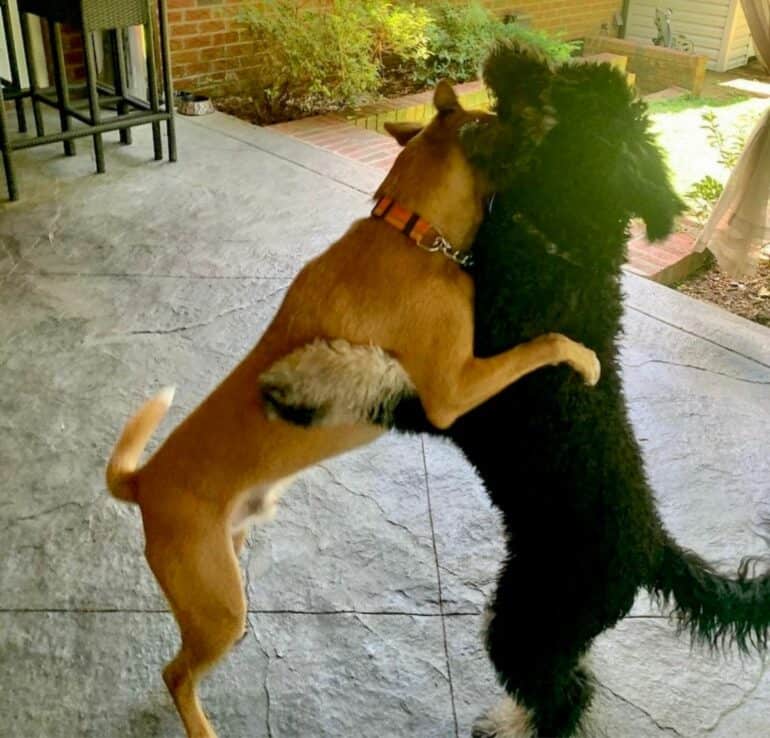
Wally on a playdate together with his Labradoodle pal Rory
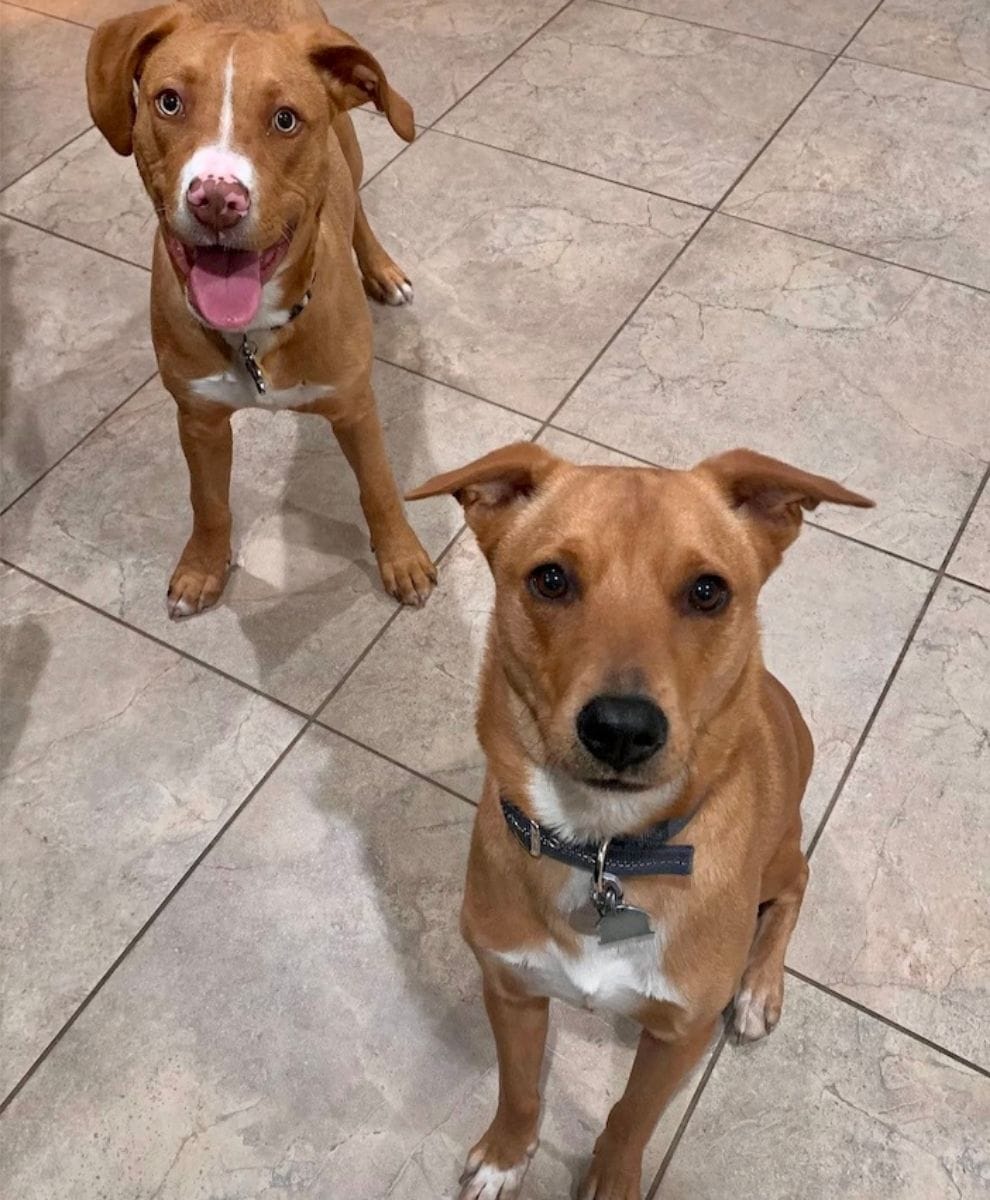
Wally socializing together with his pet pal Fonzie
2. Coaching Courses
Enroll your rescue canine in coaching courses, similar to obedience or agility courses, particularly designed for socialization.
These courses present structured environments the place your canine can be taught to observe instructions, work together with different canine, and follow good manners.
Skilled trainers can supply steerage and help, making certain the courses are constructive and productive in your canine’s socialization journey.
3. Group Canine Walks
Be a part of organized group walks or canine strolling teams in your neighborhood.
These outings enable your rescue canine to work together with different canine and their house owners in a managed and supervised setting.
Strolling collectively in a bunch offers alternatives for constructive social interactions, publicity to completely different environments, and practising good leash manners.
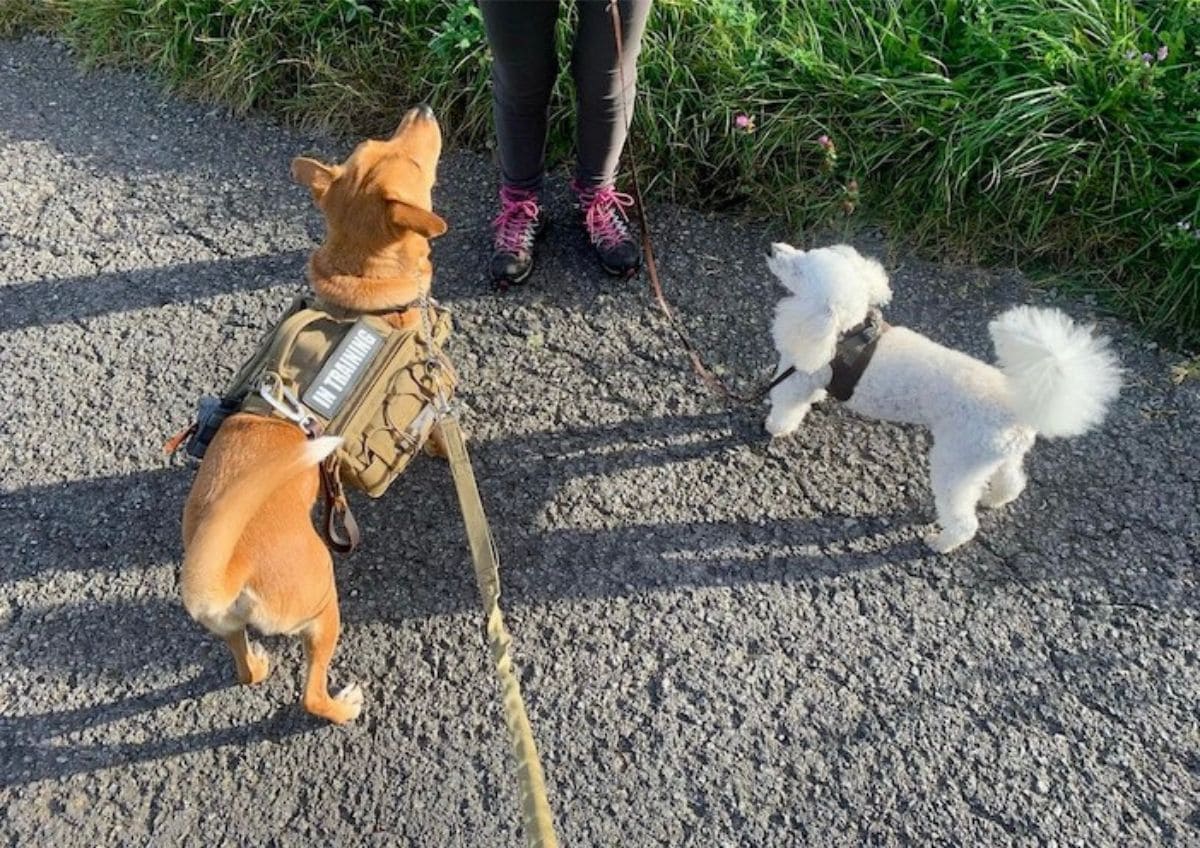
Wally out on a backpack stroll together with his doggie pal Orlando
4. Meetups and Socialization Occasions
Search for canine meetup teams or socialization occasions in your space.
These gatherings carry collectively canine house owners and their pets for socialization and play.
It’s an opportunity in your rescue canine to fulfill new canine and other people in a supportive and structured setting, selling constructive interactions and constructing confidence.
5. Managed Exposures
Progressively expose your rescue canine to varied environments, stimuli, and experiences in a managed method.
This could embody outings to pet-friendly shops, out of doors cafes with dog-friendly patios, or quiet public areas.
Guarantee your canine is snug and never overwhelmed, and use constructive reinforcement to create constructive associations with these new experiences.
6. A Phrase On Canine Parks
Whereas canine parks can present beneficial alternatives in your rescue canine to work together with different canine and other people in a managed and monitored setting, I personally am not an enormous fan of them.
That’s since you by no means know who’s going to be there and the way well-behaved (or misbehaved!) different canine are.
So for those who do wish to give canine parks a attempt, I counsel that you just start by visiting throughout quieter occasions. That’s when there’ll solely be a handful of canine which might be going to be a lot simpler to manage than a big pack of canine.
All the time observe the principles of the park and intently observe your pup’s habits to make sure they’re snug and having fun with the expertise.
Keep in mind to at all times prioritize your rescue canine’s security, well-being, and luxury throughout these actions.
Observe their physique language and reactions, and make changes as wanted.
Each canine is exclusive, so tailor the actions to your canine’s particular person wants and preferences.
With persistence, consistency, and constructive experiences, you’ll be able to assist your rescue canine develop beneficial social expertise and thrive in numerous social settings.
A Rescue Story Gone Fallacious
I can’t assist however share the story of a rescue pet that one in all my purchasers adopted.
Let’s name her Destiny (I modified the identify).
Destiny was a medium-size mutt pet who was pulled from a kill shelter when she was about 5 months previous.
The shopper ended up adopting her however sadly, they barely applied any of the methods I simply shared.
Destiny moved in with the household and their different pets and acquired alongside superb with all of them.
She acquired her personal crate however spent means an excessive amount of time in there given how a lot power she had.
Whereas she had entry to a big property, she was typically exterior unsupervised and wasn’t launched to any guidelines or provided construction.
That mentioned, she ended up biting one too many supply individuals who accessed the property, one in all whom ended up urgent fees.
This resulted in Destiny being put down.
Massive sigh.
The pup was a candy canine and will have been an exquisite companion canine IF she had been supplied guidelines and construction, coaching, and correct train.
As a substitute, she was left to her personal units and located methods to maintain herself busy.
That is clearly not what ought to have occurred, nevertheless it did.
In order a common reminder, please DO plan to spend time with any rescue canine you undertake and assist them on their journey to turning into a well mannered canine.
For those who don’t really feel like you’ll be able to take day out of your busy schedules, then don’t undertake a rescue canine.
Backside Line
It takes numerous time, power and persistence to socialize a rescue canine, and for those who’ve made it this far, it’s best to have a good suggestion of the right way to go about it!
The principle purpose in socializing rescue canine is to show them to varied individuals, animals, environments, and stimuli in a managed and constructive method.
General, socialization is essential for rescue canine to assist them overcome their previous experiences, change into well-adjusted members of their new households, and lead happier, extra fulfilling lives.
With persistence and constructive reinforcement, you’ll be able to create an setting that fosters the expansion and social integration of rescue canine.
However do not forget that socialization is a steady course of, and setbacks could happen alongside the way in which!
For those who really feel like you’ll be able to’t handle a selected habits successfully by yourself, don’t hesitate to hunt steerage from canine trainers and/or behaviorists skilled in working with rescue canine.
Let’s all attempt to keep away from conditions that find yourself badly like they did for Destiny.
Now it’s your flip – do you will have any extra recommendations on the right way to socialize a rescue canine?
We’d like to learn them within the remark part beneath this weblog publish!
Save To Pinterest
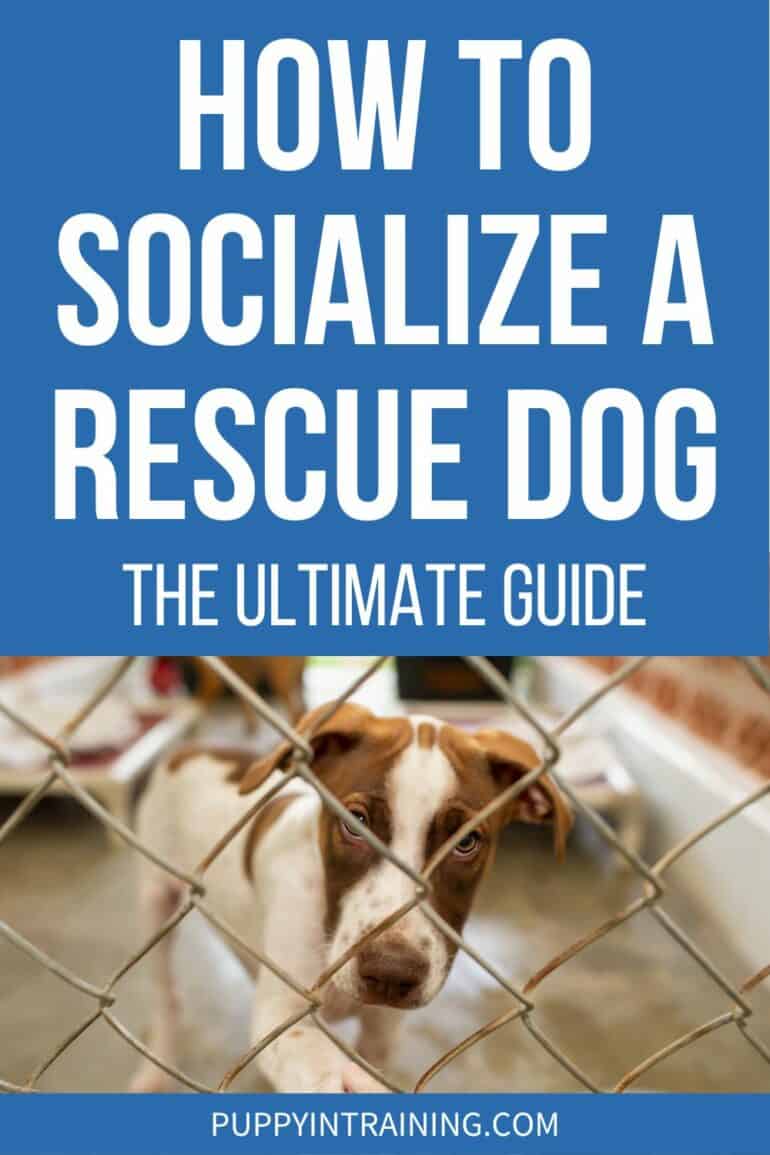
High Picks For Our Puppies
- BEST PUPPY TOY
We Like: Calmeroos Pet Toy w/ Heartbeat and Warmth Packs – Good for brand spanking new puppies. Helps ease nervousness of their new residence. - BEST DOG CHEW
We Like: Mighty Paw Naturals Bully Sticks – All of our puppies like to chew, nip, and chew. We love utilizing Bully Sticks to assist divert these undesirable behaviors. - BEST DOG TREATS
We Like: Loopy Canine Prepare-Me Treats – We use these as our high-value treats for our information canine puppies. - BEST FRESH DOG FOOD
We Like: The Farmer’s Canine – A pair months in the past we began feeding Raven recent pet food and she or he loves it! Get 50% off your first order of The Farmer’s Canine.
Take a look at extra of our favorites on our New Pet Guidelines.


